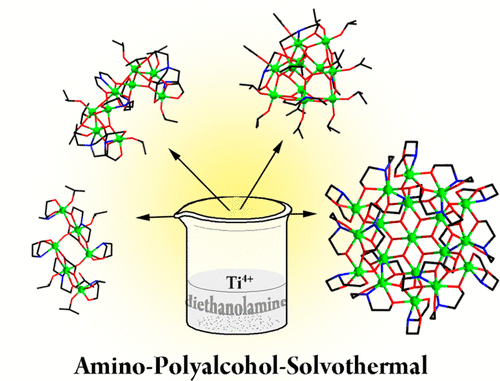当前位置:
X-MOL 学术
›
Inorg. Chem.
›
论文详情
Our official English website, www.x-mol.net, welcomes your
feedback! (Note: you will need to create a separate account there.)
Amino-Polyalcohol-Solvothermal Synthesis of Titanium-Oxo Clusters: From Ti6 to Ti19 with Structural Diversity
Inorganic Chemistry ( IF 4.3 ) Pub Date : 2019-05-22 00:00:00 , DOI: 10.1021/acs.inorgchem.9b00293 Xiao-Xue Liu 1, 2 , Shumei Chen 2 , Wei-Hui Fang 1 , Lei Zhang 1 , Jian Zhang 1
Inorganic Chemistry ( IF 4.3 ) Pub Date : 2019-05-22 00:00:00 , DOI: 10.1021/acs.inorgchem.9b00293 Xiao-Xue Liu 1, 2 , Shumei Chen 2 , Wei-Hui Fang 1 , Lei Zhang 1 , Jian Zhang 1
Affiliation

|
As is known, amino-polyalcohol ligands are usually used as sacrificial agents in photocatalytic reactions. And polyoxo-titanium clusters (PTCs) are molecular modes of titanium dioxide, one of the most important photocatalysts. In order to help understand the intrinsic coordination feature of amino-polyalcohol toward titanium-oxo species, we carried out the research of constructing PTCs with amino-polyalcohol ligands. In view of the low melting point of amino-polyalcohol, they have been directly applied as reaction mediums. Under this new synthetic method, a series of PTCs have been successfully obtained, namely, Ti6(μ2-O)2(OCH2CH2O)2(OiPr)4(dea)6·HOiPr (deaH2 = diethanolamine, PTC-171), Ti9(μ2-O)2(μ3-O)4(tea)2(OiPr)8(dea)5(teaH3 = triethanolamine, PTC-172), Ti11(μ3-O)10(μ4-O)(OiPr)14(dea)4 (PTC-173), Ti19(μ2-O)6(μ3-O)12(dea)18Cl4 (PTC-174), and Ti19(μ2-O)6(μ3-O)12(dea)18(NO3)4·(H2O)6 (PTC-175). Their structures are determined by single-crystal X-ray diffraction analysis. It is worth noting that PTC-174 and PTC-175 are not only the first Ti19 examples of crystalline PTCs, but also currently the largest PTCs compounds in the amino-polyalcohol system. Moreover, the solid-state UV–vis spectra of these PTCs were recorded. And their applications in photocurrent responses were also investigated. This work provides an interesting method for the preparation of amino-polyalcohol base PTCs and would also benefit the mechanism interpretation of the photocatalytic processes of titanium oxide materials.
中文翻译:

钛-氧簇团的氨基-多元醇-溶剂热合成:结构多样性从Ti 6到Ti 19
众所周知,氨基-多元醇配体通常在光催化反应中用作牺牲剂。聚氧钛簇(PTC)是二氧化钛的分子模式,二氧化钛是最重要的光催化剂之一。为了帮助理解氨基多元醇对钛-氧代物种的内在配位特征,我们进行了用氨基多元醇配体构建PTC的研究。鉴于氨基多元醇的低熔点,它们已被直接用作反应介质。在这种新的合成方法,已经成功地获得了一系列的PTC,即,钛6(μ 2 -O)2(OCH 2 CH 2 O)2(O我PR)4(DEA)6 ·HO我PR(DEAH 2 =二乙醇胺,PTC-171),TI 9(μ 2 -O)2(μ 3 -O)4(茶)2(O我PR)8(DEA)5( TEAH 3 =三乙醇胺,PTC-172),TI 11(μ 3 -O)10(μ 4 -O)(O我PR)14(DEA)4(PTC-173),TI 19(μ 2 -O)6(μ 3 -O)12(DEA)18氯4(PTC-174)和Ti 19(μ 2 -O)6(μ 3 -O)12(DEA)18(NO 3)4 ·(H 2 ö )6(PTC-175)。它们的结构通过单晶X射线衍射分析确定。值得注意的是,PTC-174和PTC-175不仅是第一个Ti 19结晶PTC的例子,但目前也是氨基多元醇系统中最大的PTC化合物。此外,记录了这些PTC的固态UV-vis光谱。并研究了它们在光电流响应中的应用。这项工作提供了一种有趣的制备氨基多元醇基PTC的方法,也将有助于对氧化钛材料的光催化过程进行机理解释。
更新日期:2019-05-22
中文翻译:

钛-氧簇团的氨基-多元醇-溶剂热合成:结构多样性从Ti 6到Ti 19
众所周知,氨基-多元醇配体通常在光催化反应中用作牺牲剂。聚氧钛簇(PTC)是二氧化钛的分子模式,二氧化钛是最重要的光催化剂之一。为了帮助理解氨基多元醇对钛-氧代物种的内在配位特征,我们进行了用氨基多元醇配体构建PTC的研究。鉴于氨基多元醇的低熔点,它们已被直接用作反应介质。在这种新的合成方法,已经成功地获得了一系列的PTC,即,钛6(μ 2 -O)2(OCH 2 CH 2 O)2(O我PR)4(DEA)6 ·HO我PR(DEAH 2 =二乙醇胺,PTC-171),TI 9(μ 2 -O)2(μ 3 -O)4(茶)2(O我PR)8(DEA)5( TEAH 3 =三乙醇胺,PTC-172),TI 11(μ 3 -O)10(μ 4 -O)(O我PR)14(DEA)4(PTC-173),TI 19(μ 2 -O)6(μ 3 -O)12(DEA)18氯4(PTC-174)和Ti 19(μ 2 -O)6(μ 3 -O)12(DEA)18(NO 3)4 ·(H 2 ö )6(PTC-175)。它们的结构通过单晶X射线衍射分析确定。值得注意的是,PTC-174和PTC-175不仅是第一个Ti 19结晶PTC的例子,但目前也是氨基多元醇系统中最大的PTC化合物。此外,记录了这些PTC的固态UV-vis光谱。并研究了它们在光电流响应中的应用。这项工作提供了一种有趣的制备氨基多元醇基PTC的方法,也将有助于对氧化钛材料的光催化过程进行机理解释。





















































 京公网安备 11010802027423号
京公网安备 11010802027423号